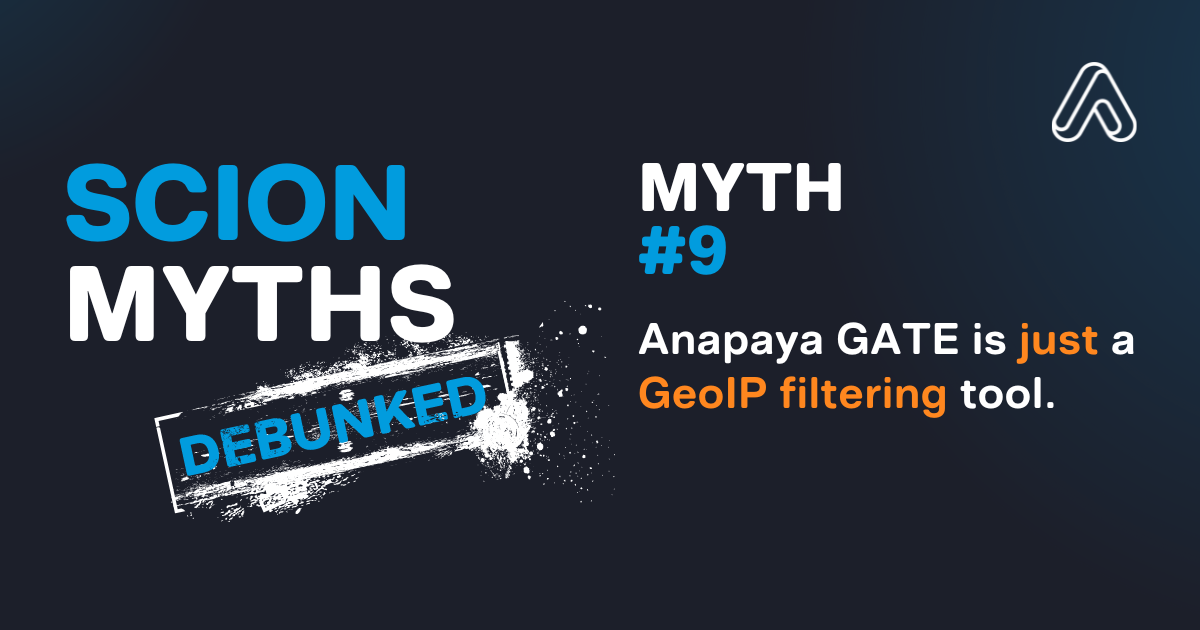False!
Anapaya GATE is not a firewall or the same thing as GeoIP filtering. Anapaya GATE operates on the Internet service provider (ISP) level and limits the exposure of critical services to the networks where its users are. That means the GATE has the capacity to reduce the attack surface of vulnerabilities. While methods like firewalls and GeoIP filtering have been the cornerstone of cybersecurity for years, they repeatedly show themselves unequal to the task of protecting businesses’ critical services. Anapaya GATE takes a fundamentally different approach with the SCION Internet.
What are firewalls and GeoIP filtering tools?
Firewalls are usually the first line of defense in any network security strategy. Positioned at the customer premises, firewalls act as gatekeepers, filtering incoming and outgoing traffic based on predetermined security rules. Most of the time, they protect the network at the network or transport level, ensuring that only legitimate traffic can pass through while blocking potentially harmful data packets. Next-generation firewalls do deep packet inspection – but this comes at a performance cost. Traditional firewalls work on layer 3 (packet filtering firewalls, like GeoIP filtering) and 4 (added ability of tracking active network connections) but do not offer the kind of granular oversight that a L7 (“deep packet” and application gateway) does.
GeoIP filtering is a feature often integrated into firewalls, allowing administrators to restrict or allow access based on the geographic location of an IP address. Think of wanting to access US movies on Netflix from Europe – it isn’t possible unless you change or feign your IP address. In general, traffic from certain regions can be blocked entirely, preventing unwanted access from areas known for high levels of cybercrime.
The market is sometimes confused about the difference between Anapaya GATE and GeoIP filtering – so let us clarify:
GeoIP filtering vs. Anapaya GATE
Protection at the customer premises vs. at the level of the Internet
❌ Geo-IP filtering happens on the IP layer, L3 – when the traffic has already reached the network of the customer (i.e., on the customer premises) and thus does not protect the firewall or the Internet access from being overwhelmed by illegitimate traffic. For example, in the case of distributed denial-of-service (DDoS) attacks, the customer firewall would be impacted along with other services. In simple terms, illegitimate and potentially harmful traffic is already at your doorstep before GeoIP filtering has the chance to block it.
✅ Anapaya GATE operates at the network level on the SCION Internet. GATE traffic is controlled at the ISP level: incoming and outgoing traffic is whitelisted before it even reaches the customer network. By allowing traffic to your service only from trusted ISPs and selected GATEs, you prevent malicious traffic from reaching the server and thereby provide a higher level of security for your service. And you get to be invisible to the rest of the Internet.
Protection from IP spoofing
❌ GeoIP filtering can allow or deny access based on geographic location. While this can block traffic from high-risk regions, it is less effective against IP spoofing, where attackers disguise their true location (or movie lovers try to watch Netflix). This is particularly relevant in the case of DDoS attacks where the attacker can use IP spoofing to mask the true origin of the traffic in a DDoS attack. By spoofing IP addresses, attackers make it appear as though the traffic is coming from various legitimate sources or different geographic regions, which complicates efforts to block the attack using GeoIP filtering.
✅ Since Anapaya GATE makes your network invisible to anyone outside the trusted ISPs within the SCION network, it also renders IP spoofing impossible.
Dependence on GeoIP databases vs. a network of trusted ISPs
❌ GeoIP filtering relies on databases of IP addresses to determine the geographic location of incoming traffic. These databases are not always accurate – due to unreliable data sources, IP address blocks being transferred from one entity to another, and simply not being updated. These issues lead to potential security gaps and ineffective filtering.
✅ Anapaya GATE is built on a network of trusted ISPs, the whitelisting of traffic is made at the ISP level. This approach offers more fine-grained control and accuracy than IP addresses of individuals.
New attack vectors and massive attack surface
❌ Traditional firewalls and GeoIP filtering are effective against known threats but do not defend against new attack vectors, such as software vulnerabilities that lead to exploits. Plus, firewalls may carry vulnerabilities themselves.
✅ Anapaya GATEs on the SCION Internet – with path control to fast-failover, all the way through to geofencing – benefit not only the ISPs who use them but also, in effect, the end user who profits from secure, streamlined services. Most importantly, the GATE on SCION reduces the attack surface of an organization’s network, eliminating several attack vectors from the bottom up.
In the end, it is fundamentally more secure to announce your service only to a targeted audience than to have the same service exposed to the entire Internet. Plus, having control over who sees your service gives you the ability to identify IP addresses of malicious actors and prosecute them legally – should the need ever arise.
So, now you are convinced that Anapaya GATE on SCION is the best practice choice for your cybersecurity practice – but now the concern becomes about the bill? Stay tuned for Myth #10 to find out why SCION is also one of the most cost-effective solutions on the market: "SCION is expensive compared to other cybersecurity solutions."
If you wish to strengthen your cybersecurity strategy with future-proof technology, Anapaya GATE on the SCION Internet is the best choice – not just today, but for tomorrow, too.
TAGS:
Anapaya GATE, SCION




.png?width=380&name=Image%20(11).png)




